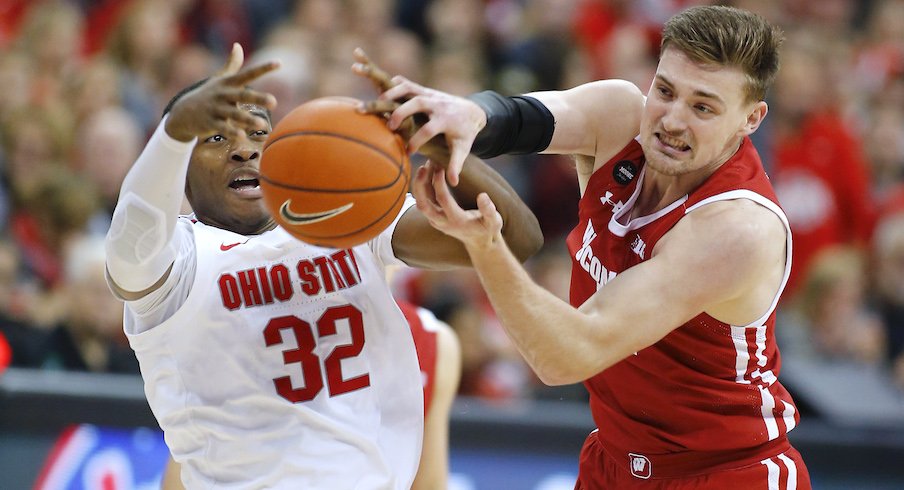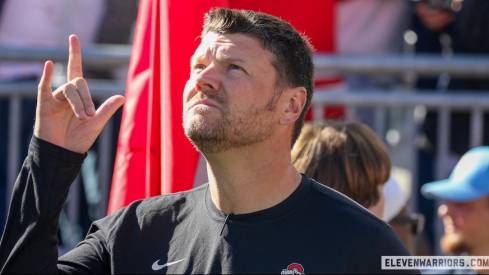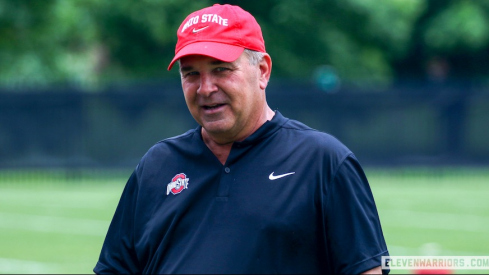Chris Holtmann stands in the same place every home game.
He’s always right at the end of Ohio State’s bench, always directly in front of the end of the scorer’s table, and always on his feet.
And when he gets so angry he has to hit something, usually once every couple games, he always turns around and slaps the scorer’s table, causing a resounding sound in the Schottenstein Center. That moment in Friday night’s 61-57 loss to Wisconsin came with 15 minutes remaining when Duane Washington Jr. caught an in-bounds pass at the top of the key out of a timeout, drove down the right side of the lane and attempted a running, floating layup over Brad Davidson.
Washington’s shot missed. Holtmann’s smack connected.
It was that kind of night for the Buckeyes, who found themselves in the far-too-familiar spot of needing somebody other than Kaleb Wesson to step up, especially down the stretch.
Wesson had a stat line that many big men would dream of. The junior scored an efficient 22 points, hitting 7-of-10 shots from the field and 7-of-9 free throws, while adding 13 rebounds, a block and a steal in 33 minutes. Before the game, Holtmann said, the coaches had thought Wisconsin would guard him with one man, potentially allowing the Buckeyes to get the Badgers into foul trouble while attacking them from the inside first.
With Wesson dominating the interior, the first part of that offensive strategy worked.
“Coaches saw that I had the hot hand early, and they decided they wanted to feed me more,” Wesson said. “And my teammates, they found me in the right spots for me to score.”
However, to maximize running an offense through a big man, Ohio State eventually needed other players around Wesson to hit shots and create some points off of action designed around getting him buckets down low.
Though the Buckeyes had been working with unsustainable shooting percentages from deep for the first couple months, they had largely managed to manufacture points elsewhere for much of the year via a variety of players.
“Toward the end, we saw that they were going to collapse and it was time for their shots,” Wesson said after the loss. “We've just got to knock those down. I trust all my teammates to hit those shots.”
On Friday, that didn’t happen.
The rest of the team collectively hit 32.4 percent of its shots and went 5-for-17 from beyond the 3-point arc.
Duane Washington Jr., who sparked the team in the first two months of the season, continued his slow rebound from a rib injury that held him out two games, scoring 18 points but hitting just 6-of-19 shots. Luther Muhammad scored two points, going 1-for-4 in 34 minutes. The freshmen had duds, with DJ Carton playing 20 scoreless minutes that included one assist and four turnovers, and E.J. Liddell scoring two points, not grabbing a rebound and committing four fouls.
Andre Wesson had the third-most points on the team but didn’t reach double figures. The Buckeyes' sole senior went 3-of-6, scoring nine points and grabbing five rebounds.
Holtmann said that before Friday’s game, he both felt “confident” that Ohio State has players who can generate offense themselves without an over-reliance on Kaleb Wesson, and that his team's play had been “spotty at times” when trying to make that happen.
“But he generated a lot of offense tonight,” Holtmann said of Wesson.
Down the stretch, the lack of offensive complements surrounding Wesson was on display for anyone watching to notice.
Wesson’s final two points came on free throws to give the Buckeyes a two-point lead with 6:32 remaining. The remainder of the game, they hit just three shots, didn’t attempt a single free throw and scored eight points, which included a triple from Duane Washington Jr. as the time expired that didn’t factor into the already determined result. Ohio State also had two turnovers during that stretch.
In those final six minutes, Wesson attempted and missed two shots, both from beyond the 3-point arc. Having him shoot from the perimeter, Holtmann said, was partially because he sees that defenses “can do everything but tackle you across the lane and it not get called.”
“It's why the NBA's completely went away from (running the offense late in games through the post),” Holtmann said. “But, listen, still he's our best player. We've got to find a way to get him the ball in those situations later. But is it harder in today's game? Absolutely. We just need other guys to respond. I thought some guys made some decent reads. We just didn't finish plays.”
With the game on the line, to whom did Holtmann turn? Wesson, of course. Naturally, the shot came from behind the 3-point line.
He missed a triple from the top of the arc with 19 seconds remaining that could have tied the game.
“That was just an action we ran to try to get him a 3 in that situation,” Holtmann said. “We've run it before. I'd have to look at it. I thought it was a little bit rushed. Don't have a problem with it.”
And nor should he. Wesson shoots 44.2 percent from 3-point range, had made one of his two earlier 3-point attempts and missed only two shots the entire game before that point.
The Buckeyes didn’t lose the game because of Wesson's end-of-game shot coming up short. Not at all. They lost, in large part, because they couldn’t find consistent offense outside of him in the latter part of the second half.
Depending too much on Wesson was arguably the most overlying theme of Ohio State's 2018-19 team. With a deeper roster this season, that hadn’t come up much in the first couple months. Considering the relative lack of precedent in the first two months, there's reason to believe what happened on Friday won't be a constantly reoccurring theme.
Yet considering that no one else was able to score consistently against Wisconsin, especially down the stretch with the game on the line and the Buckeyes coming up empty while needing baskets, it’s an area to monitor going forward.


